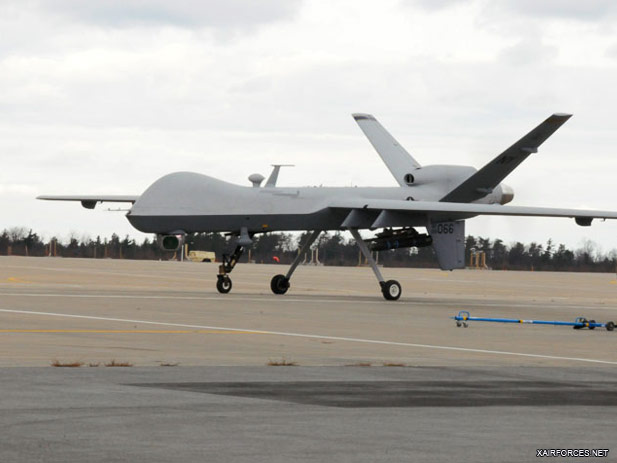
U.S. Air National Guard Begins Domestic Reaper Training

The U.S. Air National Guard is conducting training flights with the MQ-9 Reaper unmanned aircraft system (UAS) in restricted airspace around Fort Drum in western New York State, where an Air Guard wing has established the first such Reaper flight school.
The Reaper first flew from the Army base October 18 and has been flying about three times per week, according to an Army report.
Launch and recovery of the Reaper is handled by a ground crew at Wheeler-Sack Army Airfield, which is located at Fort Drum. The UAS is flown to altitude using a line-of-site radio link, then turned over to a flight crew operating from Hancock Field Air National Guard Base near Syracuse, N.Y., home of the 174th Fighter Wing.
UAS are currently prohibited from operating in unrestricted airspace with other air traffic in the U.S., and integrating manned and unmanned aircraft is still years away. The General Atomics-built Reaper, a single-engine turboprop with maximum takeoff weight of 10,500 pounds, operates in restricted airspace over Fort Drum and Lake Ontario under a certificate of authorization issued by the FAA.
Formerly an F-16 wing, the 174th is prevented from launching and recovering the UAS from its base at Hancock Field because it is collocated with Syracuse Hancock International Airport. “The fact that we have restricted airspace collocated to this military airfield [at Fort Drum] is what allowed us to gain permission from the FAA,” to fly the Reaper, stated Col. Kevin Bradley, the wing commander.
In April, the FAA and the Army began joint testing of a prototype ground-based sense-and-avoid radar system for tracking UAS at the General Atomics flight-test facility in El Mirage, Calif. That type of system does not exist at Fort Drum, but “we continue to work with industry, the FAA and Department of Defense agencies to explore fielding that capability,” the National Guard said in response to an AIN query.
There are four Reapers available for training flights from Fort Drum. The aircraft will be used to train both pilots and sensor operators from the active duty Air Force, Reserve and Air Guard units, as well as foreign military forces.
As of November, there were 87 MQ-9 Reapers in service with the Air Force and Air National Guard, less than a quarter of the planned requirement of some 400 aircraft. The Air Force operates MQ-9s at Creech Air Force Base in Nevada and Holloman and Cannon AFBs in New Mexico.
Source: 09 December 2011 - Aviation International News (www.ainonline.com)
Photo: The U.S. Air National Guard began training flights with the MQ-9 Reaper in October at Fort Drum in New York. (Photo: U.S. Army)
Photo Story: New landing gear for Predator B/MQ-9 Reaper
General Atomics Aeronautical Systems (GA ASI) has unveiled a new trailing arm design for the existing main landing gear on its Predator B/MQ-9 Reaper UAV. According to a company statement, the design will be included in Block 5 aircraft, and will enhance and extend the UAV’s utility.
GA-ASI said the enhanced landing gear is available as a field retrofit to all Predator B/MQ-9 customers upon request. Reliability and performance improvements will include 30%+ increase in landing weight capacity, at the full Federal Aviation Regulation (FAR) descent rate of 10 ft per second; growth path to increase gross takeoff weight by approximately 12% (10,500 lb vs. 11,700 lb); maintenance-free shock absorber, nitrogen pressurization not required; and full rejected takeoff brake system at growth maximum weight of 11,700 lb. It also includes provisions for automatic takeoff and landing capability and Anti-lock Brake System (ABS) field upgrades
According to the company, the new landing gear successfully underwent full qualification, fatigue testing, and flight testing in January 2011. The flight test programme included fully instrumented loads validation, taxi testing, landings at a variety of weights and sink rates, and in-flight gear-swings. Only one minor revision to the original design was required following testing, which was a tribute to the success of the initial design effort.
(By the Shephard News Team, 12 January 2012- Shephard Group / Mil-Log News (www.shephardmedia.com))
(12.01.2012)
|